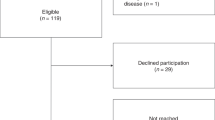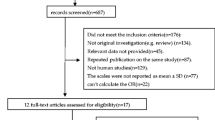Abstract
Purpose
Environmental phthalate exposure has been associated with attention deficit disorders in children. We hypothesized that in children treated in the pediatric intensive care unit (PICU), circulating phthalates leaching from indwelling medical devices contribute to their long-term attention deficit.
Methods
Circulating plasma concentrations of di(2-ethylhexyl)phthalate (DEHP) metabolites were quantified in 100 healthy children and 449 children who had been treated in PICU and were neurocognitively tested 4 years later. In a development patient cohort (N = 228), a multivariable bootstrap study identified stable thresholds of exposure to circulating DEHP metabolites above which there was an independent association with worse neurocognitive outcome. Subsequently, in a second patient cohort (N = 221), the observed independent associations were validated.
Results
Plasma concentrations of DEHP metabolites, which were virtually undetectable [0.029 (0.027–0.031) µmol/l] in healthy children, were 4.41 (3.76–5.06) µmol/l in critically ill children upon PICU admission (P < 0.001). Plasma DEHP metabolite concentrations decreased rapidly but remained 18 times higher until PICU discharge (P < 0.001). After adjusting for baseline risk factors and duration of PICU stay, and further for PICU complications and treatments, exceeding the potentially harmful threshold for exposure to circulating DEHP metabolites was independently associated with the attention deficit (all P ≤ 0.008) and impaired motor coordination (all P ≤ 0.02). The association with the attention deficit was confirmed in the validation cohort (all P ≤ 0.01). This phthalate exposure effect explained half of the attention deficit in post-PICU patients.
Conclusions
Iatrogenic exposure to DEHP metabolites during intensive care was independently and robustly associated with the important attention deficit observed in children 4 years after critical illness. Clinicaltrials.gov identifier: NCT00214916.


Similar content being viewed by others
References
Mesotten D, Gielen M, Sterken C, Claessens K, Hermans G, Vlasselaers D, Lemiere J, Lagae L, Gewillig M, Eyskens B et al (2012) Neurocognitive development of children 4 years after critical illness and treatment with tight glucose control: a randomized controlled trial. JAMA 308:1641–1650
Sterken CLJ, Vanhorebeek I, Van den Berghe G, Mesotten D (2015) Neurocognition after pediatric heart surgery: a systematic review and meta-analysis. Open Heart 2(1):e000255
Hovels-Gurich HH, Konrad K, Skorzenski D, Herpertz-Dahlmann B, Messmer BJ, Seghaye MC (2007) Attentional dysfunction in children after corrective cardiac surgery in infancy. Ann Thorac Surg 83:1425–1430
Wray J, Pot-Mees C, Zeitlin H, Radley-Smith R, Yacoub M (1994) Cognitive function and behavioural status in paediatric heart and heart-lung transplant recipients: the Harefield experience. BMJ 309:837–841
Wells FC, Coghill S, Caplan HL, Lincoln C (1983) Duration of circulatory arrest does influence the psychological development of children after cardiac operation in early life. J Thorac Cardiovasc Surg 86:823–831
Kalff AC, De Sonneville LM, Hurks PP, Hendriksen JG, Kroes M, Feron FJ, Steyaert J, van Zeben TM, Vles JS, Jolles J (2005) Speed, speed variability, and accuracy of information processing in 5 to 6-year-old children at risk of ADHD. J Int Neuropsychol Soc 11:173–183
Bellinger DC, Jonas RA, Rappaport LA, Wypij D, Wernovsky G, Kuban KC, Barnes PD, Holmes GL, Hickey PR, Strand RD et al (1995) Developmental and neurologic status of children after heart surgery with hypothermic circulatory arrest or low-flow cardiopulmonary bypass. N Engl J Med 332:549–555
Bellinger DC, Wypij D, Kuban KC, Rappaport LA, Hickey PR, Wernovsky G, Jonas RA, Newburger JW (1999) Developmental and neurological status of children at 4 years of age after heart surgery with hypothermic circulatory arrest or low-flow cardiopulmonary bypass. Circulation 100:526–532
Tasker RC (2012) Pediatric critical care, glycemic control, and hypoglycemia: what is the real target? JAMA 308:1687–1688
Kastner J, Cooper DG, Maric M, Dodd P, Yargeau V (2012) Aqueous leaching of di-2-ethylhexyl phthalate and “green” plasticizers from poly(vinyl chloride). Sci Total Environ 432:357–364
Koch HM, Preuss R, Angerer J (2006) Di(2-ethylhexyl)phthalate (DEHP): human metabolism and internal exposure—an update and latest results. Int J Androl 29:155–165
Green R, Hauser R, Calafat AM, Weuve J, Schettler T, Ringer S, Huttner K, Hu H (2005) Use of di(2-ethylhexyl) phthalate-containing medical products and urinary levels of mono(2-ethylhexyl) phthalate in neonatal intensive care unit infants. Environ Health Perspect 113:1222–1225
Weuve J, Sanchez BN, Calafat AM, Schettler T, Green RA, Hu H, Hauser R (2006) Exposure to phthalates in neonatal intensive care unit infants: urinary concentrations of monoesters and oxidative metabolites. Environ Health Perspect 114:1424–1431
Frederiksen H, Kuiri-Hanninen T, Main KM, Dunkel L, Sankilampi U (2014) A longitudinal study of urinary phthalate excretion in 58 full-term and 67 preterm infants from birth through 14 months. Environ Health Perspect 122:998–1005
Gore AC (2013) Editorial: an international riposte to naysayers of endocrine-disrupting chemicals. Endocrinology 154:3955–3956
Schug TT, Blawas AM, Gray K, Heindel JJ, Lawler CP (2015) Elucidating the links between endocrine disruptors and neurodevelopment. Endocrinology 156(6):1941–1951
FDA (2001) Safety assessment of di(2-ethylhexyl)phthalate (DEHP) released from PVC medical devices. Center for Devices and Radiological Health, Rockville
SCENIHR (2015) ECSCoEaN-IHR opinion on the safety of medical devices containing DEHP-plasticized PVC or other plasticizers on neonates and other groups possibly at risk. EU, Luxembourg
Chen T, Yang W, Li Y, Chen X, Xu S (2011) Mono-(2-ethylhexyl) phthalate impairs neurodevelopment: inhibition of proliferation and promotion of differentiation in PC12 cells. Toxicol Lett 201:34–41
Tanaka T (2002) Reproductive and neurobehavioural toxicity study of bis(2-ethylhexyl) phthalate (DEHP) administered to mice in the diet. Food Chem Toxicol 40:1499–1506
Engel SM, Miodovnik A, Canfield RL, Zhu C, Silva MJ, Calafat AM, Wolff MS (2010) Prenatal phthalate exposure is associated with childhood behavior and executive functioning. Environ Health Perspect 118:565–571
Whyatt RM, Liu X, Rauh VA, Calafat AM, Just AC, Hoepner L, Diaz D, Quinn J, Adibi J, Perera FP et al (2012) Maternal prenatal urinary phthalate metabolite concentrations and child mental, psychomotor, and behavioral development at 3 years of age. Environ Health Perspect 120:290–295
Polanska K, Ligocka D, Sobala W, Hanke W (2014) Phthalate exposure and child development: the Polish Mother and Child Cohort Study. Early Hum Dev 90:477–485
Park S, Lee JM, Kim JW, Cheong JH, Yun HJ, Hong YC, Kim Y, Han DH, Yoo HJ, Shin MS et al (2014) Association between phthalates and externalizing behaviors and cortical thickness in children with attention deficit hyperactivity disorder. Psychol Med 45(8):1–12
Masuo Y, Ishido M, Morita M, Oka S (2004) Effects of neonatal treatment with 6-hydroxydopamine and endocrine disruptors on motor activity and gene expression in rats. Neural Plast 11:59–76
Vlasselaers D, Milants I, Desmet L, Wouters PJ, Vanhorebeek I, van den Heuvel I, Mesotten D, Casaer MP, Meyfroidt G, Ingels C et al (2009) Intensive insulin therapy for patients in paediatric intensive care: a prospective, randomised controlled study. Lancet 373:547–556
Dirtu AC, Geens T, Dirinck E, Malarvannan G, Neels H, Van Gaal L, Jorens PG, Covaci A (2013) Phthalate metabolites in obese individuals undergoing weight loss: urinary levels and estimation of the phthalates daily intake. Environ Int 59:344–353
Hanawa T, Muramatsu E, Asakawa K, Suzuki M, Tanaka M, Kawano K, Seki T, Juni K, Nakajima S (2000) Investigation of the release behavior of diethylhexyl phthalate from the polyvinyl-chloride tubing for intravenous administration. Int J Pharm 210:109–115
Huygh J, Clotman K, Malarvannan G, Covaci A, Schepens T, Verbrugghe W, Dirinck E, Van Gaal L, Jorens PG (2015) Considerable exposure to the endocrine disrupting chemicals phthalates and bisphenol-A in intensive care unit (ICU) patients. Environ Int 81:64–72
Anderson V, Catroppa C, Morse S, Haritou F, Rosenfeld JV (2009) Intellectual outcome from preschool traumatic brain injury: a 5-year prospective, longitudinal study. Pediatrics 124:e1064–e1071
Amant F, Van Calsteren K, Halaska MJ, Gziri MM, Hui W, Lagae L, Willemsen MA, Kapusta L, Van Calster B, Wouters H et al (2012) Long-term cognitive and cardiac outcomes after prenatal exposure to chemotherapy in children aged 18 months or older: an observational study. Lancet Oncol 13:256–264
Mazumdar M, Smith A, Bacik J (2003) Methods for categorizing a prognostic variable in a multivariable setting. Stat Med 22:559–571
Jaber L, Halpern GJ, Shohat M (1998) The impact of consanguinity worldwide. Community Genet 1:12–17
Rappaport BA, Suresh S, Hertz S, Evers AS, Orser BA (2015) Anesthetic neurotoxicity-clinical implications of animal models. N Engl J Med 372:796–797
Jenkins KJ, Gauvreau K, Newburger JW, Spray TL, Moller JH, Iezzoni LI (2002) Consensus-based method for risk adjustment for surgery for congenital heart disease. J Thorac Cardiovasc Surg 123:110–118
Kim BN, Cho SC, Kim Y, Shin MS, Yoo HJ, Kim JW, Yang YH, Kim HW, Bhang SY, Hong YC (2009) Phthalates exposure and attention-deficit/hyperactivity disorder in school-age children. Biol Psychiatry 66:958–963
Chopra V, Harley K, Lahiff M, Eskenazi B (2014) Association between phthalates and attention deficit disorder and learning disability in US children, 6–15 years. Environ Res 128:64–69
Fan J, McCandliss BD, Fossella J, Flombaum JI, Posner MI (2005) The activation of attentional networks. Neuroimage 26:471–479
Tanida T, Warita K, Ishihara K, Fukui S, Mitsuhashi T, Sugawara T, Tabuchi Y, Nanmori T, Qi WM, Inamoto T et al (2009) Fetal and neonatal exposure to three typical environmental chemicals with different mechanisms of action: mixed exposure to phenol, phthalate, and dioxin cancels the effects of sole exposure on mouse midbrain dopaminergic nuclei. Toxicol Lett 189:40–47
Krause J (2008) SPECT and PET of the dopamine transporter in attention-deficit/hyperactivity disorder. Expert Rev Neurother 8:611–625
Acknowledgments
This work was supported by the Research Foundation-Flanders (FWO), Belgium (FWO fellowship to SV); by the Methusalem program of the Flemish government (through the University of Leuven to GVdB, METH/08/07 and to GVdB and IV, METH14/06); by an ERC Advanced Grant (AdvG-2012-321670) from the Ideas Program of the European Union 7th framework program to GVdB; and by the Institute for Science and Technology, Flanders, Belgium (through the University of Leuven to GVdB, IWT/070695/TBM).
Author information
Authors and Affiliations
Corresponding author
Ethics declarations
Conflicts of interest
The authors declare that they have no conflict of interest.
Additional information
S. Verstraete and I. Vanhorebeek have contributed equally to this article.
Take-home message: Critically ill children have very high circulating levels of phthalate metabolites, explained by leaching indwelling medical devices, and these high levels are independently associated with the important attention deficit observed 4 years later.
Electronic supplementary material
Below is the link to the electronic supplementary material.
Rights and permissions
About this article
Cite this article
Verstraete, S., Vanhorebeek, I., Covaci, A. et al. Circulating phthalates during critical illness in children are associated with long-term attention deficit: a study of a development and a validation cohort. Intensive Care Med 42, 379–392 (2016). https://doi.org/10.1007/s00134-015-4159-5
Received:
Accepted:
Published:
Issue Date:
DOI: https://doi.org/10.1007/s00134-015-4159-5




